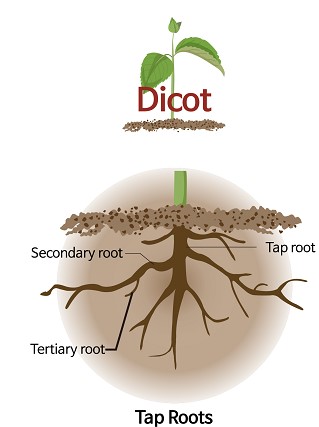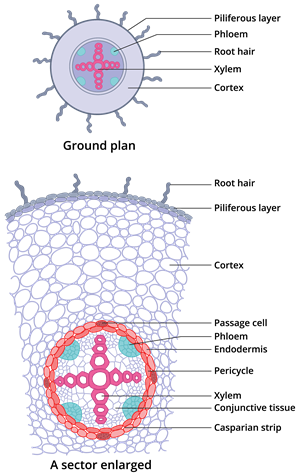PDF chapter test TRY NOW
Introduction:
Video explaining the comparison between a monocot plant and dicot plant
Dicot roots are tap root systems that help
- to anchor the plant to the soil.
- to absorb water and nutrients from the soil.
- to store food.
- to transport food, water and minerals to stem and leaves.

Dicot root
Certain parts of the plant perform these functions.

Transverse section of dicot root
The above picture is showing a sector of the transverse section of a dicot root - bean.
The following structures are seen in the section.
(i) Epiblema:
It is the outermost layer present in the dicot root. Unicellular root hairs are present in this layer, which helps in the absorption of water. It is also known as Rhizodermis or the Piliferous layer. Cuticle, a protective layer present in stems and leaves, is absent in the dicot root. Stomata, openings present in the leaf are also absent.
(ii) Cortex:
In the transverse section, the largest zone of cells present in multiple layers is called the cortex. These layers are made up of thin-walled parenchymatous cells. These cells have large intercellular spaces, and these parenchymatous cells help in the storage of food and water.
(iii) Endodermis:
Endodermis refers to the cortex's innermost layer. This layer is closely packed with barrel-shaped cells. If the above picture is observed, we can see the band like thickenings on radial and tangential walls of the endodermis cells, called casparian strips. The strip is made up of suberin. Lignin will get deposited in the later stages. This strip acts as a water dam or check post to prevent the flow of fluids between cortex and phloem and prevents plasmolysis. Endodermis cells opposite to the protoxylem are without casparian strips. These cells help move water and dissolved salts from the cortex to the xylem and are called passage cells.
(iv) Stele:
All tissues inner to endodermis constitute stele. It includes a pericycle and vascular bundle.
(a) Pericycle:
There is a single layer of parenchyma cells present inner to endodermis, called pericycle. Lateral roots originated from this layer.
(a) Vascular bundle:
It is a radial type of vascular bundle. Due to the absence of cambium, it is closed. Xylem is exarch (protoxylem directed towards periphery and metaxylem directed towards the centre). And tetrarch ( four bundles of xylem and phloem present alternatively). In between the xylem and phloem tetrarch bundles, there is a tissue called conjunctive tissue. In dicot roots, it is made up of parenchyma cells.
(c) Pith:
It is present only in young roots and absent in older roots. Even in younger roots, the pith is smaller in size.
Video explaining the internal structure of a dicot root
